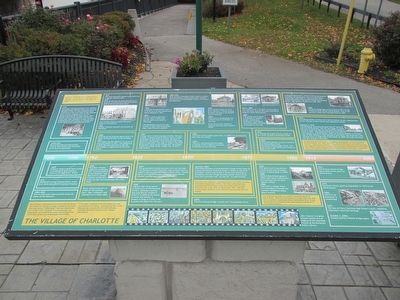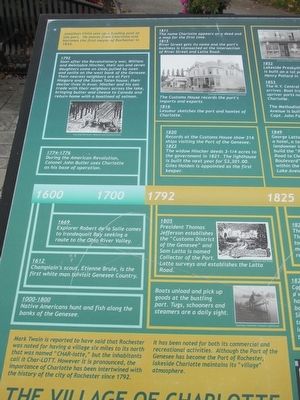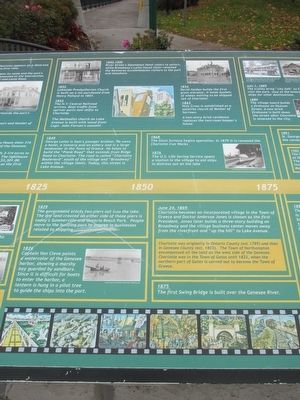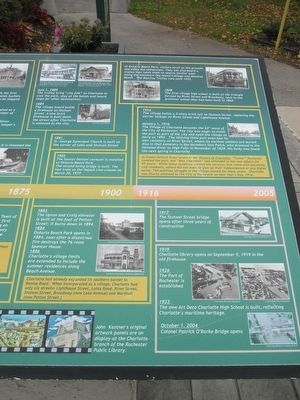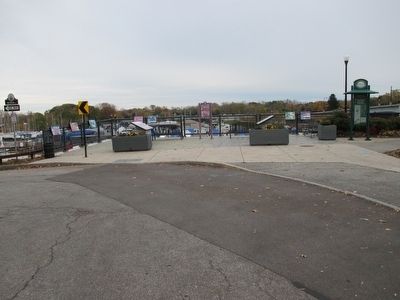Charlotte in Rochester in Monroe County, New York — The American Northeast (Mid-Atlantic)
The Village of Charlotte
Mark Twain is reported to have said that Rochester was noted for having a village six miles to its north that was named "CHAR-lotte," but the inhabitants call it Char-LOTT. However it is pronounced, the importance of Charlotte has been interwined with the history of the City of Rochester since 1792.
It has been noted for both its commercial and recreational activities. Although the Port of the Genesee has become the Port of Rochester, lakeside Charlotte maintains its "village" atmosphere.
1000-1800 Native Americans hunt and fish along the banks of the Genesee.
1612 Champlain's scout, Etienne Brule, is the first white man to visit Genesee Country.
1669 Explorer Robert de la Salle comes to Irondequoit Bay seeking a route to the Ohio River Valley.
1774-1776 During the American Revolution, Colonel John Butler uses Charlotte as his base of operation.
1792 Soon after the Revolutionary war, William and Mehitable Hincher, their son and seven daughters come on sleds pulled by oxen and settle on the west bank of the Genesee. Their nearest neighbors are at Fort Niagara and the Stone Tolan house; their doctor lives in Avon. Hincher and his son trade with their neighbors across the lake, bringing butter and cheese to Canada and return home with a boatload of salmon.
Jonathan Child sets up a trading post at the port. He moves from Charlotte and becomes the first mayor of Rochester in 1834.
Boats unload and pick up goods at the bustling port. Tugs, schooners and steamers are a daily sight.
1805 President Thomas Jefferson establishes the "Customs District of the Genesee" and Sam Latta is named Collector of the Port. Latta surveys and establishes the Latta Road.
1811 The name Charlotte appears on a deed and a map for the first time.
1815 River Street gets its name and the port's business is transacted at the intersection of River Street and Latta Road. The Customs House records the port's imports and exports.
1816 Lesueur sketches the port and hamlet of Charlotte.
1820 Records at the Customs House show 316 ships visiting the Port of the Genesee.
1822 The widow Hincher deeds 3-1/4 acres to the government in 1821. The lighthouse is built the next year for $3,301.00. Giles Holden is appointed as the first keeper.
Captain Van Cleve paints a watercolor of the Genesee harbor, showing a marshy bay guarded by sandbars. Since it is difficult for boats to enter the harbor, a lantern is hung in a pilot tree to guide the ships into the port.
1829 The government erects two piers out into the lake. The dry land created on either side of those piers is today's Summerville and Ontario Beach Park. People move to the bustling port to engage in businesses related to shipping.
1850-1900 River Street's Steamboat Hotel caters to sailors, while Broadway's Latta House (later renamed the Kenmore) accommodates visitors to the port and lakeshore.
1852 Lakeside Presbyterian Church is built on a lot purchased from Henry Pollard in 1851.
1853 The N.Y. Central Railroad arrives. Boat traffic from upriver ports now shifts to Charlotte. The Methodist Church on Lake Avenue is built with wood from Capt. John Farnan's sawmill.
1854 David Holden builds the first grain elevator; it holds bushels of wheat waiting to be shipped out of Charlotte.
1863 Holy Cross is established as a satellite church of Mother of Sorrows. A two-story brick residence replaces the two-room keeper's house.
1868 The blast furnace begins operation. In 1879 it is renamed the Charlotte Iron Works.
June 24, 1869 Charlotte becomes an incorporated village in the Town of Greece and Doctor Ambrose Jones is chosen as the first President. Jones later builds a three-story building on Broadway and the village center moves away from the riverfront and "up the hill" to Lake Avenue.
Charlotte was originally in Ontario County (est. 1789) and then in Genesee County (est. 1802). The Town of Northampton encompassed all the land on the west side of the Genesee. Charlotte was in the Town of Gates until 1822, when the northern part of Gates is carved out to become the Town of Greece.
1875 The first swing bridge is built over the Genesee River.
1876 The U.S. Lifesaving Service opens a station in the village to aid ships in distress out on the lake.
1883 The Upton and Craig elevator is built at the foot of Petten Street; it burns down in 1894.
1884 Ontario Beach Park opens in 1884, soon after a disastrous fire destroys the 76 room Spencer House.
1886 Charlotte's village limits are extended to include the summer residences along Beach Avenue.
Charlotte had already expanded its southern border to Denise Road. When incorporated as a village, Charlotte had only six streets - Lighthouse Street, Latta Road, River Street, Stutson Street, Broadway (now Lake Avenue) and Marshall (now Petten Street.)
July 1, 1889 The Trolley bring "city folk" to Charlotte to visit the park, stay at the hotels and board ships for other destinations. This is a photo taken on the first day of operation of the Charlotte trolley. The trolley barn was on the east side of Lake Avenue just north of Holy Cross Church.
1889 The village board builds a firehouse on Stutson Street. A new brick firehouse is built down the street after Charlotte is annexed to the city.
1891 St. George Episcopal Church is built at the corner of Lake and Stutson Street.
1905 The Gustav Dentzel carousel is installed at Ontario Beach Park. The second swing bridge is built. The last train on the Hojack Line crosses on March 30. 1977.
At Ontario Beach Park, visitors stroll on the grounds and enjoy the attractions. They can also board a trolley that takes them to resorts farther west along the lakeshore like Island Cottage and Manitou Beach. The Manitou trolley runs until 1925.
1908 The first village school is built at the triangle formed by River Street and Broadway, next to the grammar school that had been built in 1869.
1914 The village builds a 2-story brick jail on Stutson Street, replacing earlier lockups on River Street and Lighthouse Avenue.
January 1, 1916 The Village of Charlotte becomes the 23rd ward of the City of Rochester. The city was eager to claim the port as part of the city and eyed the village as early as 1893. The thriving litle port even had its own cemetery on River Street, where its earliest settlers are buried. Also in that cemetery is the daredevil Sam Patch, who drowned in the Genesee River at High Falls in November of 1829. His body was found the next spring in Charlotte.
As Emma Pollard Green wrote in her History of Charlotte:
"Father" Rochester coveted the port...but "Miss Charlotte had attended to her own affairs for 47 years. While many residents wanted the services that came with becoming city residents, others did not want to give up their independence or pay higher taxes. The political struggle in the village ensued for many years. Charlotte was finally annexed to the City of Rochester in New Year's Day, 1916.
1917 The Stutson Street bridge opens after three years of construction.
1919 Charlotte library opens on September 5, 1919 in the old firehouse.
1926 The Port of Rochester is established
The new Art Deco Charlotte High School is built, reflecting Charlotte's maritime heritage.
October 1, 2004 Colonel Patrick O'Rorke Bridge opens.
John Kastner's original artwork panels are on display at the Charlote branch of the Rochester Public Library.
Topics and series. This historical marker is listed in these topic lists: Industry & Commerce • Settlements & Settlers. In addition, it is included in the Art Deco series list. A significant historical year for this entry is 1792.
Location. 43° 14.964′ N, 77° 36.717′ W. Marker is in Rochester, New York, in Monroe County. It is in Charlotte. Marker is at the intersection of Stutson Street and River Street, on the right when traveling east on Stutson Street. Touch for map. Marker is in this post office area: Rochester NY 14612, United States of America. Touch for directions.
Other nearby markers. At least 8 other markers are within walking distance of this marker. Champion of the Genesee River / A Beacon of Knowledge (here, next to this marker); Boat Building (here, next to this marker); Crossing the River by Ferry (here, next to this marker); Port of the Genesee, New York (here, next to this marker); Stutson Street Bridge (here, next to this marker); Irondequoit and its Waterfront (a few steps from this marker); Resort Area (a few steps from this marker); Lighthouses (a few steps from this marker). Touch for a list and map of all markers in Rochester.
Credits. This page was last revised on February 16, 2023. It was originally submitted on November 12, 2015, by Anton Schwarzmueller of Wilson, New York. This page has been viewed 924 times since then and 102 times this year. Photos: 1, 2, 3, 4, 5. submitted on November 12, 2015, by Anton Schwarzmueller of Wilson, New York.
